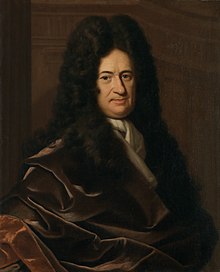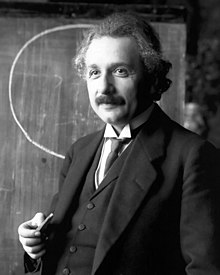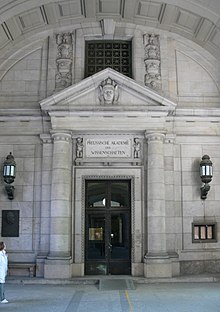Prussian Academy of Sciences

The Prussian Academy of Sciences was founded in 1700 by the Brandenburg Elector Friedrich III. Founded as the Electoral Brandenburg Society of Sciences in Berlin . It achieved worldwide fame as the Prussian Academy of Sciences. Its members included the Brothers Grimm , Wilhelm and Alexander von Humboldt , Lise Meitner , Theodor Mommsen , Albert Einstein and Max Planck . From the division to the reunification of GermanyAn East and a West Academy fought over their tradition, which has been continued by the Berlin-Brandenburg Academy of Sciences since 1992 .
story

18th century
The academy was founded on July 11, 1700 as the Electoral Brandenburg Society of Sciences by Elector Friedrich III. of Brandenburg. He appointed Gottfried Wilhelm Leibniz as its first president , who planned and developed the academy together with Daniel Ernst Jablonski . After the coronation of Elector Friedrich III. for I. King Frederick of Prussia , the academy called 1701 Royal Prussian Society of Sciences . In contrast to other academies , the Prussian Academy of Sciences was not financed from the state treasury until 1809. Rather, she had to support herself financially. To do this, she used the one proposed by Leibniz and by Friedrich III. on May 10, 1700 granted a monopoly on the manufacture and sale of calendars in the Electorate of Brandenburg . The academy only received a statute in 1710. The academy was officially opened a year later. The statute laid down the division of the academy members into four classes (two science and two humanities classes).
While other academies such as the Royal Society in London or the Académie des sciences and the Académie française in Paris limited themselves to certain areas of science, the Prussian Academy brought together natural science and the humanities from the outset. The class structure, which she introduced for the first time, was a model for later founding academies. From 1710 to 1830 the academy had two classes for the natural sciences and mathematics as well as two classes for the humanities. From 1830 to 1945 there were only two classes, the physical-mathematical and the philosophical-historical class. The classes and the plenum in which the academy members met for scientific deliberations were the decisive bodies of the Prussian Academy of Sciences.
A comprehensive reorganization of the academy took place under the reign of Friedrich II . At the beginning of 1744, the old Society of Sciences was merged with the Nouvelle Société Littéraire, founded in Berlin in 1743, to form the Royal Academy of Sciences . The statute of January 24, 1744 stipulated the public tendering of prize tasks by the academy as an innovation . The pricing tasks of the European academies determined the public discourse of the Res publica literaria , at least in the 18th century . With the award tasks, the academies took up unsolved scientific issues of their time and in this way promoted the development of the sciences. Jean le Rond d'Alembert , Johann Gottfried Herder , Moses Mendelssohn and Immanuel Kant were among those who sent prize papers to the Prussian Academy of Sciences .
The academy reached its first heyday under Friedrich II. Outstanding representatives of the natural sciences and humanities were among its members, including Leonhard Euler , Jean le Rond d'Alembert, Pierre Louis Moreau de Maupertuis , Johann Theodor Eller , Andreas Sigismund Marggraf , Johann Heinrich Lambert , Joseph Louis Comte de Lagrange , and Franz Carl Achard , François Marie Arouet de Voltaire , Charles de Secondat, Baron de Montesquieu , Jean-Baptiste de Boyer, Marquis d'Argens , Julien Offray de La Mettrie , Denis Diderot , Gotthold Ephraim Lessing , Daniel Friedrich Sotzmann , Christoph Martin Wieland and Immanuel Kant .
In the 18th century the academy had its own research facilities: 1709 Berlin observatory ; 1717 Theatrum Anatomicum , from 1723 Collegium medico-chirurgicum ; 1718 Botanical Garden (Berlin) ; 1753 Laboratory and scientific cabinet of curiosities with a physical cabinet, natural history cabinet and herbarium .
19th century
In the course of the profound reorganization of the academy in the years 1806 to 1812, which was concluded with the new statute of January 24, 1812, the academy gradually lost its scientific facilities to the newly founded Friedrich-Wilhelms-Universität . As the new main form of scientific work, scientific undertakings were founded at the Academy from 1815, led by academic commissions chaired by a full member of the academy. In addition to the academy members appointed to the commissions, the work in these large joint ventures was mainly carried out by scientists who were employed by the academy management. This is how over 50 scientific undertakings arose here, including were headed by the Commission for Greco-Roman Antiquities, the German Commission, the Oriental Commission or the Prussian Commission. From 1812 it was called the Royal Prussian Academy of Sciences in Berlin:
“The term Royal Prussian Academy of Sciences in Berlin should be appropriate from 1812, it was in use since the turn of the 19th century. A hyphen was not used. In the written tradition from this period there are various names, such as Berlin Academy, Royal Academy of Sciences, Academy of Sciences etc. There are probably also documents in which a hyphen was placed between 'Royal' and 'Prussian'. In the Academy's statutes of January 24, 1812 - as in earlier statutes - only the abbreviated version of the Academy of Sciences is used. However, the German-language academy treatises were already called 'Treatises of the Royal Academy of Sciences in Berlin' from 1804 to 1819 and 'Treatises of the Royal Academy of Sciences in Berlin' from 1820 to 1901. From 1901 the addition 'zu Berlin' was missing (treatises of the Royal Prussian Academy of Sciences). In the printed reports on the negotiations of the academy from 1836 to 1855, in the monthly reports of the academy (1856–1881) and in the reports of the meetings of the academy (1882–1901), however, the title of the Royal Prussian Academy of Sciences in Berlin always appeared so that this designation - without a hyphen - is probably correct from 1812. "
The capital of 1.5 million Marks (1871) donated by Elise Wentzel-Heckmann from Berlin in 1894 , the interest proceeds of which became one of the Heckmann Wentzel Foundation , born with it, Hermann and Elise, from 1894 onwards, was an important aid for scientific work Third of the academy was available. The funding was advertised for “comprehensive scientific endeavors requiring greater expenditure”. Any ordinary academician could apply for the research to be funded. A college of seven , consisting of the Minister of Spiritual Affairs, etc. (or his deputy) and three members each, elected from both classes of the Academy for a period of five years, decided on the award. After 1945 some academy institutes emerged from the academy commissions and the offices of the corresponding companies.
time of the nationalsocialism
During the time of National Socialism , the academy was also to be subjected to synchronization . Jewish employees and members had to leave the academy. With the new statutes of June 8, 1939, the academy was headed according to the leader principle by a president who was assisted by a vice-president, the two class secretaries and the director. However, the Academy refused to confirm Theodor Vahlen , who was provisionally appointed by the Reich Ministry of Education and proposed as President, in the election, which was still planned for a new President , and agreed internally on its own candidate, which meant that the post remained vacant until the end of the war.
Traditional successor
After the end of the war, the academy was initially subordinate to the Berlin magistrate . On July 1, 1946, the Academy was reopened in Germany as the German Academy of Sciences in Berlin by the Soviet military administration . In 1972 it was renamed the Academy of Sciences of the GDR , which functioned both as a learned society and, comparable for example to the Max Planck Society , as the supporting organization of a research community of non-university research institutes.
After the German reunification came at the end of 1991 on the dissolution of the GDR Academy and for subsequent reconstitution of the Berlin-Brandenburg Academy of Sciences (BBAW) according to international treaty the countries Berlin and Brandenburg from 21 May 1992. 122 former members of the East German Academy founded In 1993 the Leibniz Society of Sciences in Berlin was another institution alongside the Berlin-Brandenburg Academy of Sciences .
Members


Men
- Samuel Walther , 1729 absent member
- Conrad Mel , 1701 absent member
- Sebastian Gottfried Starcke , 1701 full member
- Johann Fabricius , 1703
- Jacob Paul Freiherr von Gundling , President of the Academy
- Otto von Graben zum Stein , Vice President of the Academy from 1732 to 1740
- Claude Gros de Boze , 1740, External Member
- Leonhard Euler , 1741 member present; 1766 Absent member
- Conrad Iken , 1745
- Johann Heinrich Lambert , 1764
- Johann Matthias Gesner , 1744 External Member
- Friedrich Heinrich von der Hagen , 1841
- Charles-Louis de Secondat, Baron de la Brède et de Montesquieu , 1746 Foreign Member
- Pierre Louis Moreau de Maupertuis , 1746, President of the Academy from 1746 to 1753
- Julien Offray de La Mettrie , 1748, full member
- Johann Georg Sulzer , 1750, director of the philosophical class from 1776
- Denis Diderot , 1751 Foreign Member
- Jérôme Lalande , 1751 Foreign Member
- Jean-Baptiste de Boyer, Marquis d'Argens , 1744, full member
- Franz Carl Achard , full member 1776, director of the physical class from 1782
- Immanuel Kant , 1786 Foreign Member
- Friedrich August Wolf , 1799 External Member; 1808 full member; 1812 honorary member
- Friedrich Schleiermacher , 1810 full member
- August Boeckh , 1814 full member
- Johann Centurius von Hoffmannsegg , 1815
- Carl Ritter , 1822 full member
- Christian Gottfried Ehrenberg , 1827 full member
- Karl Lachmann , 1830 full member
- Michael Faraday , 1842 External Member
- Emil du Bois-Reymond , 1851 full member
- Heinrich Ernst Beyrich , 1853 full member
- Theodor Mommsen , 1853 corresponding member; 1858 full member
- Hermann von Helmholtz , 1857 corresponding member; 1870 Foreign member; 1871 full member
- Eduard Zeller , 1864 corresponding member; 1872 full member; 1894 honorary member
- Rudolf Virchow , 1873 full member
- Franz Kielhorn , 1880 corresponding member
- Gustav von Schmoller , 1884 full member
- Adolf von Harnack , 1890 full member
- Ulrich von Wilamowitz-Moellendorff , 1891 corresponding member; 1899 full member
- Ferdinand Georg Frobenius , 1893 full member
- Louis Duchesne , 1893 Corresponding Member
- Max Planck , 1894 full member
- Henri Weil , 1896 Corresponding Member, 1908 External Member
- Melchior Treub , 1900 Corresponding Member
- Albert Einstein , 1914 full member
- Karl Holl , full member in 1915
- Ernst Heymann , 1918 full member
- Kurt Sethe , 1920 Corresponding Member; 1930 full member
- Otto Hahn , 1924 full member
- Max Bodenstein , 1925 full member
- Karl Hampe , 1925 corresponding member
- Hermann Grapow , 1938 full member
- Hans von Euler-Chelpin , 1942 Corresponding Member
Women
In 1776 Frederick II ensured the honorary membership of his cousin, the Russian Tsarina Catherine II , and his successor in 1794 for the membership of Juliane Giovane , who had emerged with writings of the Enlightenment . One hundred years later , after discussions, the patron Maria Elisabeth Wentzel-Heckmann was elected the third female honorary member. In 1964 Liselotte Welskopf-Henrich was elected as the first woman to be a full member of the successor organization, the German Academy of Sciences.
See also
literature
-
Adolf Harnack : History of the Royal Prussian Academy of Sciences in Berlin , edited on behalf of the Academy, Berlin 1900. Four volumes:
- From the foundation to the death of Frederick the Great , Volume 1, Part 1 - Internet Archive .
- From the Death of Frederick the Great to the Present , Volume 1, Part 2 - Internet Archive .
- Documents and files on the history of the Royal Prussian Academy of Sciences , Volume 2 - Internet Archive .
- General register of the scientific treatises and ceremonial speeches published in the Academy's writings from 1700–1899. Edited by Dr. Otto Köhnke. Volume 3 - Internet Archive .
- Alfred Meusel, Gerhard Thiele (collaborator): From the Electoral Brandenburg Society to the German Academy of Sciences , In: Johannes Irmscher (editor), Werner Radig (editor): German Academy of Sciences in Berlin 1946–1956. Published by the German Academy of Sciences in Berlin. Akademie-Verlag, Berlin 1956, pp. 1-17.
- Werner Hartkopf: The Berlin Academy of Sciences. Its members and award winners 1700–1990. Akademie Verlag, Berlin 1992. ISBN 3-05-002153-5 , ( online at Google Books ).
- Katrin Kohl: The Berlin Academy as a medium of cultural transfer in the context of the European Enlightenment. In: Frederick the Great: Politics and Cultural Transfer in a European Context. Contributions of the fourth colloquium in the series "Friedrich300" from 24./25. September 2010, ed. by Michael Kaiser and Jürgen Luh . Online publication on perspectivia.net .
- Rolf Winau : Prussian Academy of Sciences. In: Christoph J. Scriba (Ed.): The elite of the nation in the Third Reich. The relationship of academies and their scientific environment to National Socialism (Acta historica Leopoldina, 22). Halle / Saale 1995, pp. 75-88.
- Wolfram Fischer (Ed.): The Prussian Academy of Sciences in Berlin 1914–1945. Akademie-Verlag, Berlin 2000. ISBN 3-05-003327-4 .
- Katrin Joos: Scholarship and claim to power around 1700. The foundation of the Berlin Academy of Sciences in the field of tension between dynastic, urban and scientific interests. Böhlau, Cologne and others 2012. ISBN 978-3-412-20714-4 .
Web links
- Chronicle on the BBAW website
- All presidents of the BBAW and its predecessor academies
Individual evidence
- ↑ https://www.bbaw.de/die-akademie
- ^ Leonhard Stroux: The foundation of the Brandenburg Society of Sciences by Gottfried Wilhelm Leibniz and Daniel Ernst Jablonski. In: Joachim Baalcke, Werner Korthaase (Ed.): Daniel Ernst Jablonski. Religion, science and politics around 1700. Harrassowitz Verlag, Berlin 2008, ISBN 978-3-447-05793-6 . Pp. 409-434.
- ^ Hermann and Elise née Heckmann Wentzel Foundation (BBAW) .
- ↑ Misc . In: Centralblatt der Bauverwaltung , September 28, 1894; P. 412; Retrieved April 18, 2015.
- ↑ From 1939 the director was the orientalist Helmuth Scheel .
- ↑ Peter Th. Walther: The German Academy of Sciences in Berlin as a place for academic and science-political border crossing in the Cold War. In: Ruth Heftrig, Bernd Reifenberg (ed.): Science between East and West. The art historian Richard Hamann as a border crosser. Jonas Verlag, Marburg 2009, ISBN 978-3-89445-427-2 , pp. 61-62.
- ^ Theresa Wobbe : Women in academy and science. Places of work and research practices 1700-2000. Akademie Verlag, Berlin 2002, p. 2.
